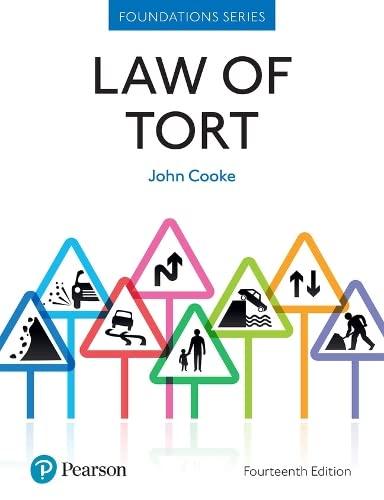Question
I need to summarize the following case and I am having hard time. It is not complete, but I just need to summarize what I
I need to summarize the following case and I am having hard time. It is not complete, but I just need to summarize what I have. Thanks.
No. 19-840
In the Supreme Court of the United States
- THE STATES OF CALIFORNIA, COLORADO, CONNECTICUT, DELAWARE, HAWAII, ILLINOIS, IOWA, MASSACHUSETTS, MICHIGAN, MINNESOTA, NEVADA, NEW JERSEY, NEW YORK, NORTH CAROLINA, OREGON, RHODE ISLAND, VERMONT, VIRGINIA, AND WASHINGTON, ANDY BESHEAR, THE GOVERNOR OF KENTUCKY, AND THE DISTRICT OF COLUMBIA, Petitioners,
v.
THE STATE OF TEXAS, et al.,
Respondents.
ON WRIT OF CERTIORARI TO THE UNITED STATES COURT OF APPEALS FOR THE FIFTH CIRCUIT
INTRODUCTION
Congress transformed our Nation's healthcare system when it enacted the Patient Protection and Affordable Care Act (ACA). The ACA has allowed tens of millions of Americans to obtain high-quality healthcare coverage; slowed the growth of healthcare costs; conferred substantial savings on States, local governments, and hospitals; improved health out- comes; and funded responses to emerging public health crises. Many of its reforms have proven indispensable in the context of the current pandemic.
Since its enactment, the ACA has also been a centerpiece of the Nation's political debates. Congress has considered numerous proposals to repeal the Act or to eliminate its core reforms. Every one of those proposals has failed, including a series of bills in 2017. The 2017 Congress instead made a focused change to the Act by reducing to zero the amount of the tax imposed by 26 U.S.C. 5000A on Americans who choose not to buy health insurance. That amendment retained every other provision of the ACA while eliminating the only legal consequence for individuals who decide to forgo health insurance.
Based on that single change, opponents of the ACA now seek from the courts what they failed to accomplish through the political process: invalidation of the entire Act. They argue that the 2017 amendment transformed Section 5000A into a command to buy insurancea command that would be unconstitutional under National Federation of Independent Business v. Sebelius, 567 U.S. 519 (2012) (NFIB). And they contend that this purported defect requires the courts to strike down every other provision of the ACA as welldespite the fact that Congress left each of those.
2
provisions in place at the same time that it rendered Section 5000A effectively unenforceable by reducing the tax amount to zero. Those arguments have no basis in law or in congressional intent. This Court should decline respondents' invitation to impose a breathtakingly broad national policy change under the guise of constitutional adjudication.
OPINIONS BELOW The opinion of the court of appeals is reported at 945 F.3d 355 (J.A. 374-489). 1 The order denying rehearing en banc (J.A. 490-491) is unreported. The relevant orders of the district court are reported at 340 F. Supp. 3d 579 (Pet. App. 163a-231a) and 352 F. Supp. 3d 665 (Pet. App. 117a-162a).
JURISDICTION The court of appeals had jurisdiction over petitioners' appeal of the district court's partial final judgment under 28 U.S.C. 1291. The judgment of the court of appeals was entered on December 18, 2019. J.A. 492. The jurisdiction of this Court rests on 28 U.S.C. 1254(1).
CONSTITUTIONAL AND STATUTORY PROVISIONS INVOLVED Relevant constitutional and statutory provisions are reproduced in the appendix to this brief.
1 After petitioners filed their petition, the court of appeals issued a revised opinion containing technical changes. The revised opinion is included in the joint appendix.
3
STATEMENT
A. Legal Background
1. The Affordable Care Act In 2010, Congress adopted the Patient Protection and Affordable Care Act. Pub. L. No. 111-148, 124 Stat. 119. "The Act's 10 titles stretch over 900 pages and contain hundreds of provisions." NFIB, 567 US. at 538-539. They address, among other things, the market for private health insurance (Title I), public health insurance programs (Title II), the quality and efficiency of healthcare systems (Title III), chronic disease and other public health issues (Title IV), the healthcare workforce (Title V), transparency in healthcare (Title VI), access to innovative therapies (Title VII), community living assistance services (Title VIII), revenue provisions (Title IX), and other matters, including Indian healthcare (Title X).
a. One of the ACA's central goals was "to increase the number of Americans covered by health insurance." NFIB, 567 U.S. at 538. Congress pursued that goal in several ways. First, it allowed States to expand the number of people eligible for Medicaid, with the federal government covering most of the increased cost. See 42 U.S.C. 1396a(a)(10)(A)(i)(VIII), 1396a(e)(14)(I)(i), 1396d(y)(1); NFIB, 567 U.S. at 575- 586 (plurality opinion).
Second, it expanded access to employer-based health insurance. For example, the ACA requires companies with more than a certain number of full- time-equivalent employees to provide health coverage or pay a penalty. 26 U.S.C. 4980H. And it requires insurers to allow young adults to stay on their parents' plans until age 26. 42 U.S.C. 300gg-14.
Step by Step Solution
There are 3 Steps involved in it
Step: 1

Get Instant Access to Expert-Tailored Solutions
See step-by-step solutions with expert insights and AI powered tools for academic success
Step: 2

Step: 3

Ace Your Homework with AI
Get the answers you need in no time with our AI-driven, step-by-step assistance
Get Started


